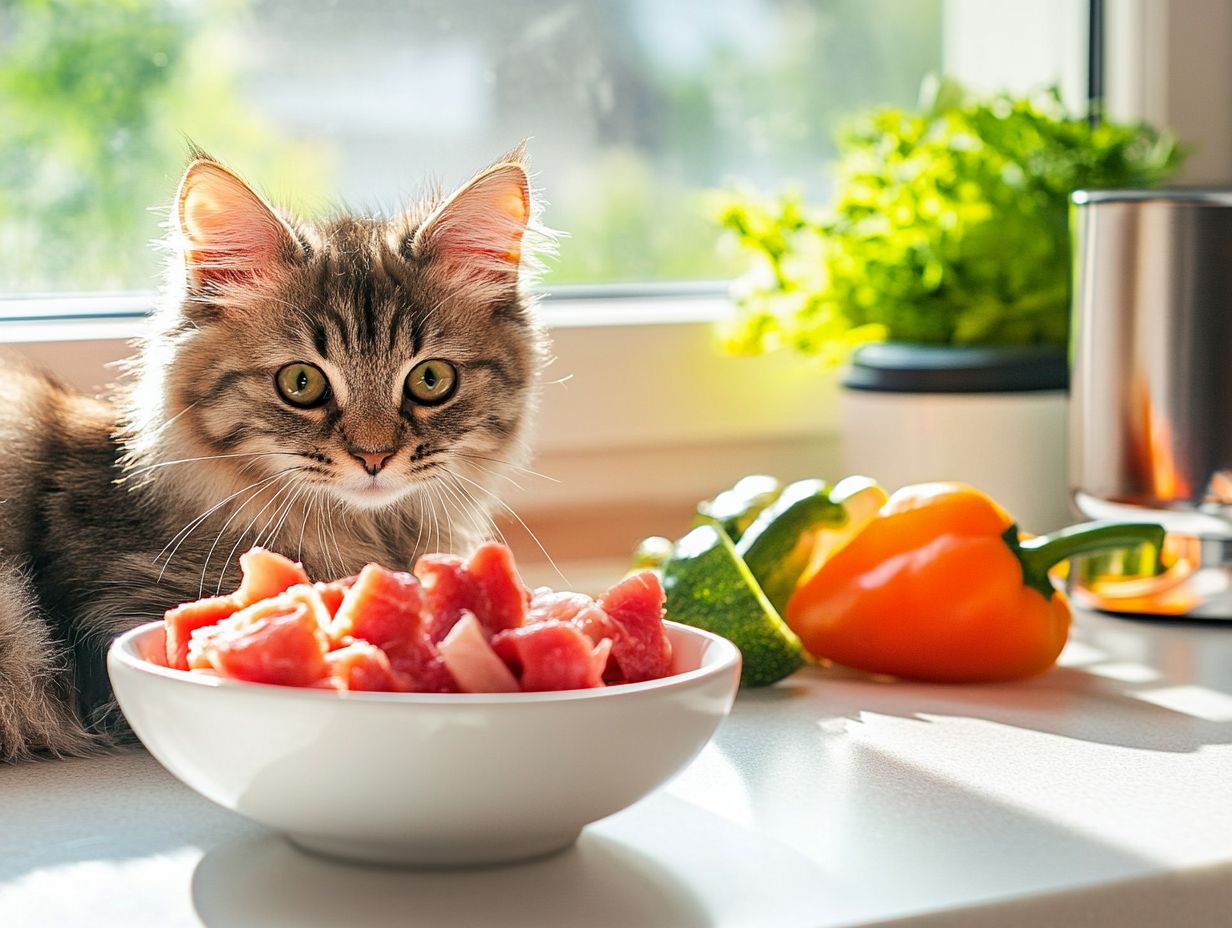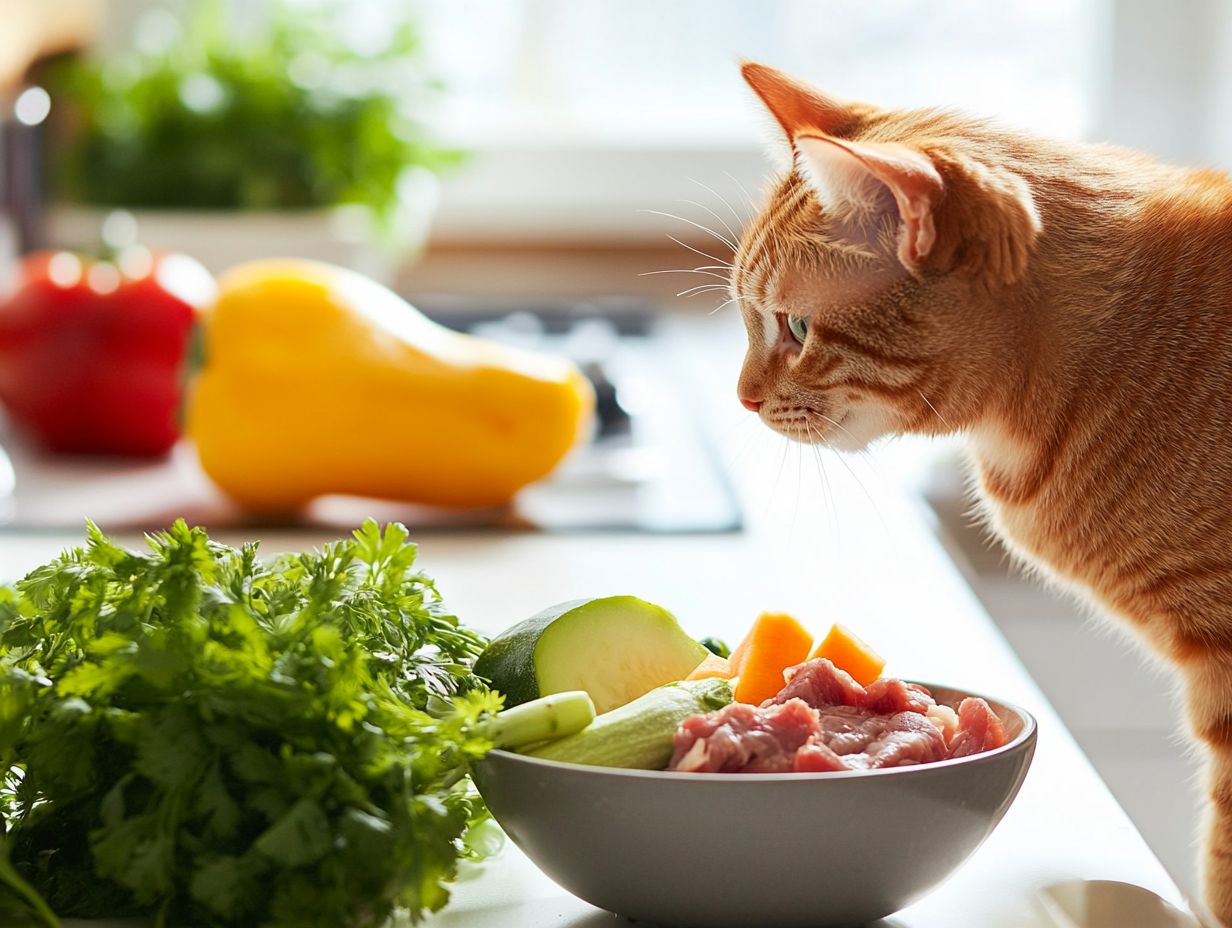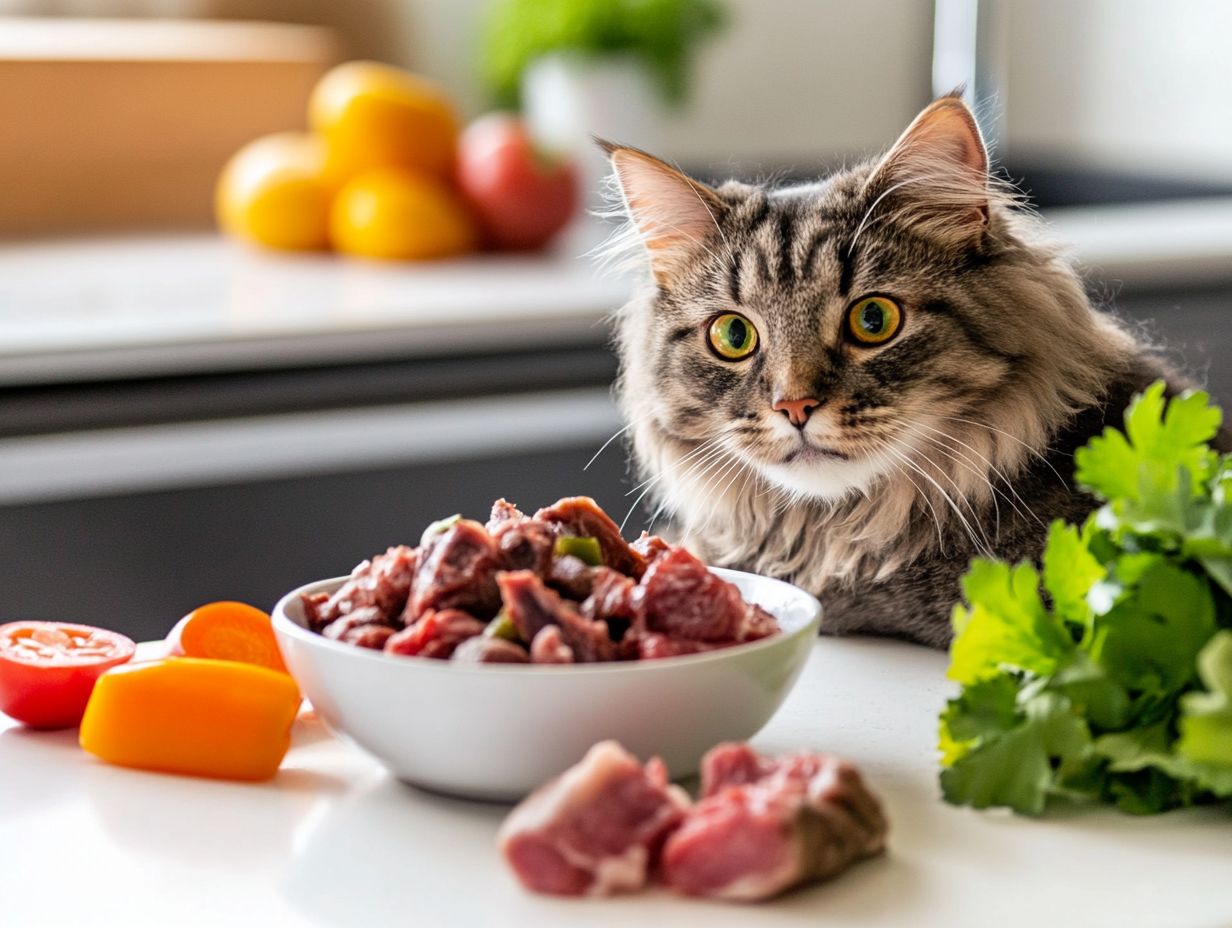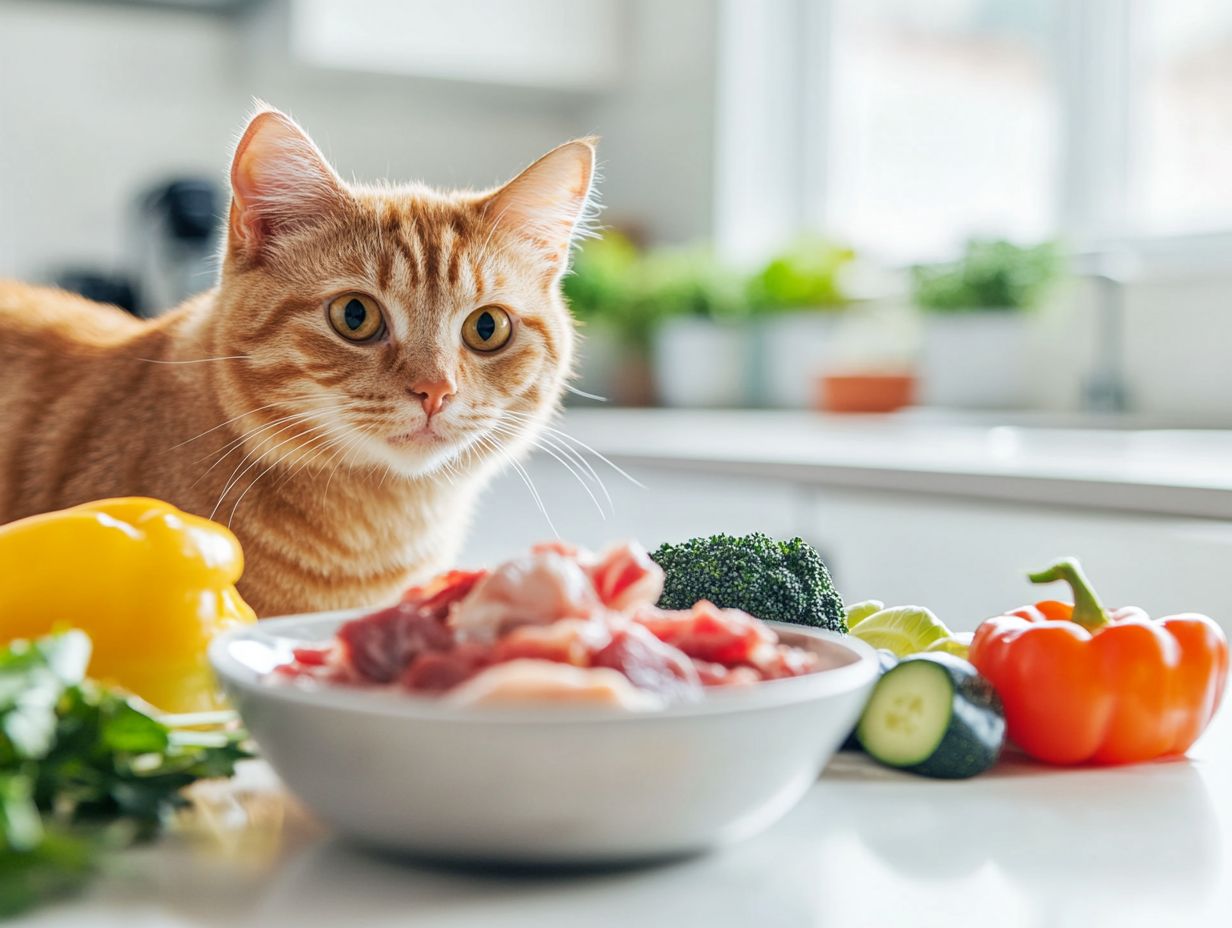The Raw food diet has gained traction among pet owners as a way to help cats shed excess weight through a high-protein approach. However, it is crucial to consult with a veterinarian before making any dietary changes, as individual health needs vary significantly.
This guide explores the essentials of raw cat food, its growing popularity for weight loss, the role of properly balanced animal proteins, and the various benefits it offers. It also addresses potential risks such as bacterial contamination and the importance of sourcing quality ingredients.
It discusses the different types of raw cat food available, tips for preparing it safely with quality ingredients, and effective low-calorie diet plans to consider, including clear guidelines on how to avoid nutritional deficiencies.
If you’re looking to help your cat achieve a healthier weight with proper hydration and healthy skin, while being mindful of their unique health conditions, this comprehensive guide is for you!
Key Takeaways:

- Raw cat food is a popular approach to help cats lose weight and maintain a healthy weight. However, it should be tailored to individual health needs, taking into account conditions like kidney disease or diabetes.
- Pre-made and homemade raw cat food are both viable options for weight loss, but it’s important to choose high-quality raw ingredients and follow balanced recipes that meet the specific dietary needs of your cat.
- Consult with a veterinarian or veterinary nutritionist before starting any raw diet plan. They can provide guidance tailored to your cat’s life stage—whether they are a kitten, adult, or senior.
- Handling raw food safely is essential to minimize health risks associated with bacterial contamination. Follow proper food storage and preparation guidelines.
What Is Raw Cat Food?
Raw cat food is a diet primarily composed of unprocessed and uncooked ingredients, including muscle meat, organ meat, and raw bones. This diet aims to supplement a cat’s overall nutrition by providing balanced animal proteins that are rich in essential amino acids, such as taurine, as well as vital micronutrients, including vitamins and minerals. It’s important to note that cats are obligate carnivores, requiring animal-source proteins for optimal health.
One popular brand that offers pre-made raw food is Stella & Chewy’s. However, some pet owners who are committed to the benefits of a raw diet prefer to prepare homemade raw cat food themselves, with caution to ensure a balanced composition.
Why Is Raw Cat Food Popular for Weight Loss?
The growing popularity of raw cat food for weight loss is attributed to its high protein and low-calorie content, making it ideal for cats that need to shed pounds while still receiving essential nutrients. Many cat owners are turning to a raw diet as an effective strategy for achieving and maintaining a healthy weight.
Raw diets often promote increased water intake and encourage an active lifestyle due to their highly digestible nature. By focusing on balanced nutrition, these diets ensure that cats receive optimal protein and nutrient allocation, meeting their dietary requirements without unnecessary fillers. However, it is essential to ensure that formulations meet AAFCO and WSAVA guidelines.
What Are the Benefits of Raw Cat Food for Weight Loss?
Raw cat food offers numerous benefits for weight loss, primarily by providing a balanced nutritional profile that promotes healthy digestion and reduces the risk of obesity. The natural ingredients found in raw cat food, such as fresh meats and bones, supply essential nutrients often lacking in processed diets. However, this requires careful preparation to avoid nutrient deficiencies.
This leads to improved metabolic function, which encourages weight loss by ensuring energy is utilized more efficiently. Additionally, the high protein content in raw meals helps regulate appetite, reducing the likelihood of snacking and overeating.
By incorporating raw options, pet owners can help address obesity-related issues such as diabetes and arthritis while ensuring their pets receive the vitamins and minerals necessary for overall well-being. Significant improvements in a cat’s health and energy levels can often be observed after transitioning to a raw diet, provided it is done under veterinary guidance.
What Are the Different Types of Raw Cat Food?
Today, there are various types of raw cat food available, including both pre-made and homemade options to accommodate different preferences and dietary needs, catering to an array of raw food choices and feeding guidelines.
Pre-made raw food for cats is often offered by established brands known for their quality products, such as Stella & Chewy’s. On the other hand, homemade raw cat food is prepared by the owner, allowing for greater customization and control over the selection of ingredients to better meet their cat’s health and dietary requirements. However, it is crucial to implement safe handling practices and ensure nutritional adequacy.
1. Pre-made Raw Cat Food
Pre-made raw cat food offers a convenient solution for pet owners who wish to provide their cats with a raw diet without the hassle of meal preparation, ensuring balanced nutrition in every serving.
Brands such as Stella & Chewy’s create carefully formulated recipes that emphasize animal-source proteins and essential nutrients, making it easier for cat owners to support their pets’ health without compromising on food safety or quality. It is recommended for cat owners to consult with their veterinarian before starting a pre-made raw food diet to ensure it meets their cat’s specific health needs.
The simplicity of these products allows busy pet owners to effortlessly provide a diet rich in natural ingredients while addressing concerns about nutritional adequacy.
When selecting pre-made raw food, it is essential to consider the sourcing of ingredients to ensure that all components meet high standards and comply with established pet food safety regulations. This careful consideration not only enhances the overall safety of the meals but also instills confidence in their nutritional adequacy, allowing cat parents to nurture their furry friends with the assurance that they are receiving wholesome, biologically appropriate diets.
2. Homemade Raw Cat Food

Homemade raw cat food enables pet owners to customize their cats’ diets using high-quality raw ingredients, ensuring that their specific dietary needs are met for optimal health. By preparing meals at home, cat owners can choose from a variety of protein sources, including muscle meat, organ meat, and bone, while incorporating essential vitamins and minerals to create balanced nutrition that supports their pets’ overall well-being.
Understanding the nutritional requirements of felines is crucial in this process. Since cats are obligate carnivores, they thrive on diets rich in protein and certain fats, making it vital to select the right ingredients. Consulting with a veterinarian is essential to avoid nutrient deficiencies and to establish a balanced diet specific to different life stages (kittens, seniors, etc.).
It is important to note the potential risks associated with homemade diets, such as bacterial contamination, and the significance of ensuring proper food handling and storage practices.
Owners should conduct thorough research and consult with veterinarians or pet nutritionists to develop recipes that meet their cats’ specific needs, thereby avoiding common pitfalls such as nutrient deficiencies. Effective preparation methods include grinding or finely chopping meats and mixing in supplements like fish oil or taurine, ensuring that meals are both tasty and nutritionally complete. Additionally, it is important to include essential nutrients like taurine, arachidonic acid, and certain vitamins that may be lacking in some homemade diets.
Regular monitoring and occasional adjustments to the diet may be necessary to maintain optimal health.
How to Prepare Raw Cat Food for Weight Loss?
Preparing raw cat food for weight loss involves determining your cat’s individual caloric needs, selecting high-quality ingredients, and adhering to a balanced recipe to ensure optimal nutrition and dietary fulfillment.
1. Calculate Your Cat’s Calorie Needs
Calculating your cat’s calorie needs is the essential first step in preparing raw cat food for weight loss, ensuring that their diet is appropriately tailored to support healthy weight loss. By taking into account factors such as age, weight, activity level, and health status, you can accurately determine your cat’s calorie requirements, providing the necessary intake for effective weight loss while still ensuring they receive adequate nutrition. Weight loss should be gradual and monitored by a veterinarian to prevent health issues.
There are several methods to calculate these calorie needs, including the Resting Energy Requirement (RER) formula, which establishes the baseline calories required based on a cat’s ideal weight. The formula for RER is: RER (kcal/day) = 70 × (ideal body weight in kg)^0.75.
You can also utilize tools such as online calculators or consult your veterinarian for tailored recommendations specific to your cat. It’s important to make adjustments based on activity levels, as more active cats may require more calories, while less active ones may need fewer. Additionally, any preexisting health issues should be considered, as they can significantly impact dietary and caloric needs.
2. Choose High-Quality Ingredients
Selecting high-quality ingredients is essential for preparing raw cat food, as the nutritional value of the food directly affects a cat’s health and weight loss success. Utilizing quality protein sources and fresh raw ingredients while avoiding fillers can lead to a better nutritional profile, thereby enhancing support for a cat’s weight loss and health requirements. It is also important to avoid common allergens and toxic foods such as onions, garlic, and chocolate.
When choosing high-quality raw cat food ingredients, it is important to consider the sourcing to ensure they come from reliable and ethical suppliers. Fresh ingredients are particularly beneficial, as they contain higher nutrient levels that can significantly aid a cat’s metabolism.
Always regularly check for spoilage and be aware of signs of food spoilage in raw diets to ensure health and safety.
Quality raw cat food ingredients should include essential vitamins and minerals such as taurine, vitamins A, D, and E that support weight-loss efforts and overall feline health. By focusing on ingredients that promote satiety and energy, pet owners can help their cats not only lose and maintain weight but also improve their health and vitality.
3. Follow a Balanced Recipe
Following a balanced recipe when preparing raw cat food is essential for ensuring that all necessary nutrients, vitamins, and minerals are included to promote overall feline health. A well-rounded recipe addresses the specific dietary requirements of cats and supports weight loss goals, helping to prevent common nutritional deficiencies like a lack of certain vitamins.
To achieve this, it is important to incorporate a variety of protein sources, such as muscle meat, organ meats, and certain types of bones to provide calcium. Each ingredient plays a crucial role; for instance, organ meats are rich in essential vitamins, while muscle meat supplies the protein needed for muscle maintenance and energy. It is crucial to include animal-source proteins to provide necessary amino acids, especially taurine, which is vital for feline health.
Omega-3 fatty acids can be added through fish or flaxseed to support healthy skin and coat health. Additionally, fiber from vegetable sources and probiotics are vital components for digestive health, completing a balanced diet that promotes overall well-being and supports weight loss objectives. However, it is important to consult a veterinarian to ensure that all dietary needs are met, especially for cats with specific health conditions.
What Are Some Effective Raw Cat Food Diet Plans for Weight Loss?
There are several effective raw cat food diet plans designed for weight loss, including options like Stella & Chewy’s, each offering distinct benefits and approaches to promoting a healthy lifestyle for cats. It is important for pet owners to consult with their veterinarian before making any significant dietary changes.
The BARF (Biologically Appropriate Raw Food) diet, along with other raw protein-based diets, provides high-quality protein and essential nutrients while supporting healthy digestion and responsible weight loss. However, pet owners should be aware of the potential risks, such as bacterial contamination (e.g., Salmonella, E. coli), and ensure proper food handling and storage practices.
Pet owners can choose from a variety of plans tailored to meet their cats’ specific dietary needs, ensuring they receive the essential protein and nutrients required for health while being aware of the importance of balanced nutrition.
1. The Prey Model Diet

The Prey Model Diet mirrors the natural feeding habits of cats by using whole prey animals as the primary protein source, providing a complete and balanced diet rich in essential amino acids and taurine. This diet includes raw muscle meat, organs, and bones to ensure that essential nutrients and natural fats are delivered in a manner that aligns with a cat’s evolutionary dietary needs.
By avoiding the artificial additives and fillers commonly found in commercial pet foods, this natural approach promotes enhanced health and vitality. Because it replicates the nutritional profile of wild prey, many pet owners notice improvements in their cats’ coat condition, dental hygiene, and energy levels.
Additionally, weight loss is a natural outcome of this diet, as it encourages the maintenance of lean muscle while reducing the intake of processed carbohydrates that can contribute to obesity. Ultimately, the Prey Model Diet represents a return to natural feeding patterns, significantly enhancing a cat’s nutritional health while addressing their instinctual behaviors, and promoting clean teeth and proper hydration. However, it is important to ensure that the diet is balanced to avoid nutritional deficiencies.
2. The BARF (Biologically Appropriate Raw Food) Diet
The BARF (Biologically Appropriate Raw Food) Diet for cats emphasizes the importance of providing a diet consisting of raw foods that closely resemble their natural prey and support healthy digestion. This diet includes various protein sources, as well as raw fruits and vegetables, to ensure balanced nutritional content.
The BARF Diet not only supports weight loss but also offers numerous nutritional benefits that promote healthy digestion, optimal hydration, and overall well-being. By aligning more closely with the natural diets of felines, the BARF Diet can enhance their vitality and energy levels. It effectively meets the dietary needs of cats by supplying essential amino acids, vitamins, and minerals found in raw meats and organ tissues.
However, there are challenges associated with feeding the BARF Diet, including concerns about safety and nutritional balance. Pet owners may find the complexities of meal preparation and sourcing high-quality ingredients overwhelming. It is crucial to monitor nutritional balance and consult a veterinarian for advice on necessary supplements, their dosages, and risks of over-supplementation.
Nevertheless, when followed correctly, the BARF Diet can significantly improve the quality of life for cats, enhancing their health and well-being while addressing digestive issues and nutrient deficiencies.
3. The Frankenprey Diet
Disclaimer: Before making significant dietary changes for your cat, it is crucial to consult with a veterinarian to ensure compliance with the AAFCO and WSAVA guidelines on raw and homemade diets.
The Frankenprey Diet is a raw feeding method that enables cat owners to customize the animal protein sources in their pet’s diet, ensuring a varied and balanced nutritional profile. This diet consists of a combination of raw ingredients, including muscle meat, organs, and bones, tailored to meet the specific dietary needs of cats while promoting healthy weight management and providing essential nutrients.
This flexibility allows owners to experiment with a diverse array of animal proteins, making mealtime more enjoyable and ensuring a balanced intake of vitamins and minerals. Cats often respond positively to different tastes and textures, making this method more likely to be accepted and helping to reduce the risk of nutritional deficiencies and potential allergens.
For those interested in this approach, it is important to introduce new proteins gradually and observe their cat’s reactions. Maintaining a balanced rotation of meats such as chicken, beef, and fish can optimize health benefits and assist with weight management by delivering essential nutrients without excess calories. Additionally, it is vital to ensure that all animal sources used in the Frankenprey diet are sourced from reputable suppliers to avoid contamination. Over time, owners can adjust the protein sources based on their cat’s individual health issues and preferences.
4. The Whole Prey Diet
The Whole Prey Diet consists of entire prey animals and provides a complete and balanced nutritional profile that closely resembles a cat’s natural diet. By feeding whole animals, this approach ensures that cats receive not only protein but also essential animal fat, vitamins, and minerals that fulfill their overall dietary needs while aiding in health and weight management.
This method acknowledges the evolutionary diet of cats as hunters and emphasizes the importance of raw meat and organ tissues. The Whole Prey Diet includes muscle meat, bones, and organs, which not only satisfy their natural cravings but also help with weight control, as these components are naturally lower in calories compared to commercial pet foods. However, it is crucial to avoid feeding cooked bones, which can splinter and cause harm.
Additionally, this diet promotes optimal hydration, as the moisture content in whole prey contributes to overall hydration, which is vital for kidney function. By mimicking the way cats would naturally eat in the wild, the Whole Prey Diet supports weight management while meeting their specific nutritional requirements.
5. The Homemade Cooked Diet
The Homemade Cooked Diet enables pet owners to prepare meals that meet their cats’ nutritional needs by combining high-quality ingredients with a focus on balanced nutrition. While this approach differs from traditional raw diets, it serves as a viable option for those seeking more control over their cats’ meals while ensuring they receive the essential nutrients for health and healthy weight management.
To develop a successful homemade diet, owners should begin by selecting lean proteins, carbohydrates, and healthy fats, using fresh meats, vegetables, and grains that are safe for feline consumption. Be mindful to avoid common toxic ingredients, such as onions, garlic, and chocolate, when preparing these meals. Cooking methods such as steaming or baking help preserve nutrients like vitamins and minerals while enhancing flavor.
It is essential to consult with a veterinarian or a pet nutritionist to ensure that the meals meet specific dietary requirements, as achieving nutritional balance—particularly in essential vitamins and minerals like taurine—is crucial. This consideration is especially important for cats with specific health issues like kidney disease or diabetes.
By thoughtfully crafting these meals, owners can provide a satisfying diet that supports weight management and fulfills essential dietary needs, ultimately leading to healthier and happier pets, while promoting optimal digestion. Proper food storage and handling practices are also vital to prevent spoilage; always check for signs of spoilage before feeding your cat.
Frequently Asked Questions
1. Can raw cat food help with weight loss?

Yes, raw cat food can be an effective diet plan for cats struggling with weight issues. This is because raw food is more nutrient-dense and can better regulate a cat’s metabolism, leading to weight management.
2. What are the benefits of using raw cat food for weight loss?
Raw cat food is beneficial for weight management as it contains fewer carbohydrates and more protein compared to dry cat food. Protein helps cats feel full and satisfied, leading to reduced calorie intake.
3. Are there any risks associated with feeding raw cat food?
While raw cat food can be a healthy diet plan, there are some risks involved, such as exposure to foodborne pathogens and harmful bacteria like Salmonella. It’s important to source high-quality and properly handled raw food to minimize these risks. Recent studies indicate that while raw diets may have benefits, they also require careful consideration and professional guidance.
4. How should I transition my cat to a raw food diet for weight loss?
It’s best to transition your cat gradually to a raw food diet to avoid digestive upset. Start by mixing small amounts of raw food into their regular food and gradually increase the amount until they are fully transitioned. This process may take a few weeks. If you notice any signs of digestive upset, please consult with a veterinarian immediately.
5. Can all cats benefit from a raw food diet for weight loss?
While a raw food diet is necessary to ensure proper nutrition for all cats, it may not be suitable for every individual. Health conditions, age, lifestyle, and individual dietary needs must be considered when evaluating the suitability of a raw food diet for each cat. It is crucial to consult with your veterinarian before making any dietary changes.
6. How can I ensure my cat is getting all the necessary nutrients on a raw food diet?
A balanced raw food diet should contain a variety of protein sources, organ meat, and some bone to provide all necessary nutrients, including essential amino acids, L-Carnitine, and vitamins and minerals, for your cat’s overall health and weight loss. Potential nutritional deficiencies, such as taurine deficiency, may arise from an improperly balanced raw food diet. It’s also important to consult with a veterinarian or a feline nutritionist to ensure your cat’s diet is complete and balanced according to AAFCO standards. Regular veterinary check-ups are essential to monitor nutrient levels and overall health.
7. What are the risks associated with feeding a raw food diet to my cat?
Feeding a raw food diet comes with potential risks, including bacterial contamination that can lead to foodborne illnesses. It is vital to practice safe food handling practices to prevent these risks. Always consult with a veterinarian before making any dietary changes, especially for cats with existing health conditions or special dietary needs.
8. How can I manage portion control and caloric needs for my cat’s weight loss?
When transitioning to a raw food diet for weight loss, portion control is critical. Monitor your cat’s caloric intake based on the latest feline obesity guidelines, which suggest specific caloric needs based on weight, age, and activity level. Proper portion sizes help ensure effective weight management while still providing a balanced diet.
9. What constitutes a balanced raw food diet for cats?
A balanced raw food diet includes specific examples of protein sources such as chicken, turkey, and beef, along with organ meat like liver and heart. It should also incorporate essential vitamins and minerals. Properly balancing these components is key to maintaining your cat’s health and facilitating weight loss.